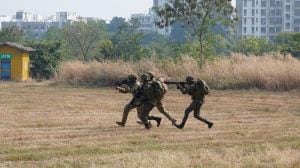Rise of a regional satrap marks a shift in BJP politics: national party, local issues
B S Yeddyurappa’s ascent marks a shift in BJP politics - the template may be national but regional issues and leaders will dominate.

B S Yeddyurappa’s ascent marks a shift in BJP politics — the template may be national but regional issues and leaders will dominate.
During his election campaign, where he managed to touch almost all the assembly constituencies, he devoted considerable time to assembly-specific issues during his election meetings. “I have not seen any other state BJP leader doing this,” admitted a psephologist who trailed Yeddyurappa on his campaign.
Issues such as Hindutva were relegated to the backburner in the Karnataka campaign. The party earmarked issues for regions such as Mumbai-Karnataka and Hyderabad-Karnataka.
With the Karnakata victory, the BJP not only exploded the Hindi-Cow-belt myth, it also marked the rise of Yedyurappa as a new regional satrap, much in the mould of Narendra Modi. Unlike Modi, however, Yeddyurappa is not interested beyond Karnataka.
“Atal Behari Vajpayee and L K Advani asked me to become a minister at the Centre, but I always desired to work for the state,” he told The Indian Express.
From being a lone ranger in the state Vidhan Soudha in 1989 to leading the party to a stunning victory with 110 MLAs, the former deputy chief minister has clearly come a long way. Save for an occasional dip or two, the party, under this farmer’s leader from Shimoga, has seen an increase in its vote share over the years — from 3.4 per cent of the popular vote in 1985, to 4 per cent, 17 per cent, 20 per cent, 28 per cent and around 33 per cent in ‘89, ‘94, ‘99, 04, and ‘08 respectively.
Once threatened by a powerful rival in state politics, he even contemplated parting ways with the party that he built brick by brick. After the early morning leads on Sunday made it clear that he had broken new ground for the BJP, Yeddyurappa called up party president Rajnath Singh, general secretary in charge of elections, Arun Jaitley, and star campaigner Sushma Swaraj, besides L K Advani. “But for the campaign plan drafted by Arun Jaitley, we would not have got the numbers. I also thanked my party president for giving me Jaitley as the prabhari (in charge),” Yedyurappa told The Indian Express.
The rise of the BJP in the state has been in many ways coterminous with that of Yeddyurappa who deftly used his Lingayat identity, RSS background, the farmer constituency and alliances with non-Congress parties to his, and his party’s, benefit.
While the Lingayats rallied behind him, he actively used the burgeoning Sangh Parivar network to his advantage. Except for South Karnataka, where the RSS doesn’t have much of a presence, he was able to establish a synergy between the caste mutts, neo-age Hindu seers, and the Sangh Parivar.
While the Lingayat mutts always backed him, even the Vokkaligga mutts, sympathetic to Deve Gowda and S M Krishna, are said to be on good terms with the Parivar. In 2006, he supported the VHP movement on the Datta Peetha, and later even made generous endowments to religious institutions sympathetic to the Sangh Parivar.
The alliances that the party struck under him with Ramkrishna Hegde, S Bangarappa and the Deve Gowda clan helped the party gain a foothold in virgin territories. Known as a leader with a penchant for padyatras, he managed to make deep inroads into the state farmers’ with his pro-farmer budget, as finance minister in the last alliance government in the state. “He waived loans up to Rs 25,000 and offered loans to farmers, weavers and fishermen at 4 per cent interest. This left a lasting imprint on the farmer community,” said a Yeddyurappa aide.
This was clearly visible when in the first pre-poll survey that it commissioned early this year, the BJP, considered to be an urban phenomenon, was found to be especially strong in rural areas. But then Yeddyurappa has always defied popular trends. His campaign was, thus, a regional phenomenon, centering on the great betrayal and promise of a new deal to the farmers.





- 01
- 02
- 03
- 04
- 05


























